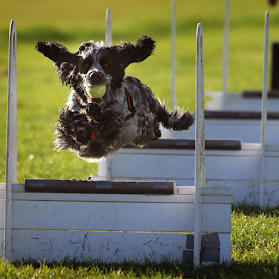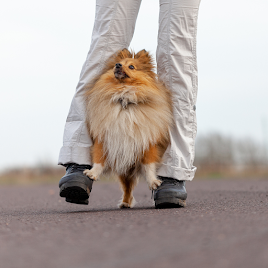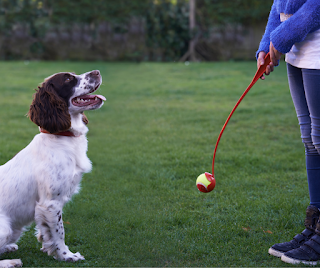6 Activities Your Dog Will Love
6 Activities Your Dog Will Love
Agility
Agility involves a series of obstacles including jumps, weave poles, see-saws, A-frames and tunnels. The idea is that your dog understands how to navigate these obstacles safely and quickly, as competitions are timed to determine the winner.Agility training should only be carried out by qualified instructors. This not only ensures that you and your dog are taught correctly, but also safely as well.
Any breed or size of dog can take part in agility. It is a great way to not only exercise your dog physically, but also mentally. It is also a great way to strengthen the bond you share with your dog, as you work together as a team to navigate the obstacle course.
Flyball
Flyball is essentially a relay race for dogs, which involves them running down a set of four jumps and retrieving a tennis ball from the flyball box. They then return to their handler, carrying the ball, back over the same four jumps, before the next dog in the team does the same and so on.There are 4 dogs in a flyball team and each one must successfully jump all the jumps there and back and bring the tennis ball back across the start line for their run to be clear. If they miss a jump, or drop the ball, then they get a fault. Any dogs that have received a fault, then has to re-run again.
The aim is for the full team of dogs to complete this process as quickly as possible, in order to win against the opposing team who is running in the lane next to them!
It is a high adrenaline, fast-paced, exciting sport for both the dogs and their handlers. Again, any breed or size of dog is able to take part in flyball, but it is important that they are trained to do so properly, to reduce the risk of potential injuries occurring.
Obedience
Obedience covers a wide range of different areas, from basic obedience classes all the way up to competitive obedience shows. Any dog will benefit from attending basic obedience classes, as they are a great way to teaching your dog to work around distractions whilst giving you the knowledge of how to train them effectively.If you decide to take their obedience training further, there are lots of classes available which focus on training for competition level. Exercises include heelwork both on and of the lead, recall, retrieve and stay. The idea is for your dog to be accurate at executing these exercises, with the difficulty increasing as you work through the levels.
Any breed of dog can take part, although many of the competitive obedience shows require your dog to be registered with The Kennel Club so be sure to look into that if you decide competitive obedience is for you.
Heelwork To Music
Heelwork To Music is split into two categories, Heelwork To Music (HTM) and Freestyle.
The HTM aspect originates from the heelwork element of obedience. The aim is to choreograph a routine to music which involves your dog being in the heel position for at least two thirds of the routine. The rest of the routine can be freestyle, which allows for a little more freedom.
The Freestyle element is made up of at least two thirds freestyle moves with up to a third being heelwork. Again this routine is choreographed to music and this must relate to the song lyrics, or tell a story throughout. Most of these freestyle routines involve the dog and their handler dressing up or using props in order to add substance to their story telling.
Although both branches of heelwork to music are sometimes considered to be not as formal as other dog sports, they are actually very technical to train and require a strong bond between the dog and their owner.
Cani X
Canicross which is often shortened to Cani X is essentially running with your dog. Any breed or size of dog can do it and it can be just done for fun and exercise, or you can choose to compete too.When running, dogs should wear a well fitting harness, there are several that are specifically designed for Cani X. They should then be encouraged to lean into the harness and pull forward. Many runners choose to have their dog fastened to a bungee type lead fastened around their waist, to keep their hands free.
Despite common belief, this will not encourage your dog to pull on the lead, as they should be able to associate their Cani X harness with running, and their normal walking attire with walking sensibly.
Cani X can be trained alone or you can join a group that specialises in helping you with training. Not only does it maintain your dog's fitness but it will keep you in shape too!
Hoopers
Hoopers is similar to agility, in that your dog navigates hoops, barrels and tunnels. However, hoopers is a little less intense than agility and does not involve tight turns, making it more accessible to dogs of any age and size.Therefore, it makes it an ideal choice for older dogs as there is less impact on their joints. Hoopers still provides a great deal of mental stimulation for your dog though as well as strengthening the bond you share as you work as a team.
Although it is a relatively new sport in comparison to the ones we have looked at, there are increasing numbers of training classes becoming available all over the country, so there is likely to be one close to you to help you get involved.
To find out more about activities your dog will enjoy, why not read Canine Contentment - The Essential Guide
To keep up to date with more of my blogs, you can find me on Facebook, Charlotte Garner - Canine Author








Comments
Post a Comment